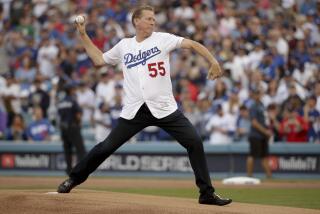His Best Sinker Was A Pay Cut
- Share via
VERO BEACH, Fla. — If the IRS agent, who monitored Orel Hershiser IV’s annual income tax returns, had to hazard a guess as to whose it was, he might suspect it was filed by:
--Nick the Greek.
--Ivan Boesky.
--A man who robbed banks for a living.
--A guy who reneged on his bets to the Mafia.
--A guy who flunked arithmetic.
--A guy who needed a new broker, or accountant.
--A guy whose calculator broke down or developed a stutter.
--A guy who put his money on very slow horses or very fast women.
I mean, who files a return for a little over $200,000 one year, a little over $1 million the next, and a couple hundred thousand less the following year? Guys jump off bridges with less fluctuation.
Try to imagine, if you will, coming home to the little woman after she’s had a long, arduous afternoon on Rodeo Drive trying to make up her mind whether to get the waterfall earrings or a new Jacuzzi and having to say, “Honey, you better think in terms of making the old drapes do. I’ve had a tough day at the office. Took a slight dip in pay, you might say.”
And, when she asks, “How much?” you answer, “Oh, about $8,000 a week.”
The good news is, how many people do you know offhand who could take an eight-grand-a-week cut and not have to be pulled off a ledge?
Banks have to fail or countries have to fall, usually, to produce that kind of catastrophic drop in cash flow. But Orel Hershiser didn’t lose it in the commodities market or at the crap table or to an agent who put him in Texas oil the week before the glut showed up. Orel’s assets sank because his fastball didn’t.
To get to be a million-dollar-a-year man, you used to have to own a railroad or corner the market in wheat or invent the electric light. Now you just need a good curve. Or serve. Or a jump shot.
It’s hard to think of anybody being ruined by a million dollars. And it wasn’t as if Orel Hershiser were going to put his money immediately into drinking champagne out of a slipper or lolling around the French Riviera, spooning caviar onto croissants.
“It’s not as if I have to sell off my yacht or a second Rolls-Royce. I
don’t have to move my family into a Winnebago,” Hershiser protests.
It was just a business setback. Sales were off, you might say.
The romance of Orel Hershiser remains that he made one of the quantum salary leaps in the history of corporate America in 1986 when his gross pay for the year jumped from $212,000 to more than $1 million.
The arbitrator who awarded this to him was impressed by the fact that Orel’s victory total had gone from 14 to 19 but was even more impressed with the fact his defeat total had gone from 8 to 3.
Presumably, the arbitrator computed his 1985 performance at $54,000 a victory.
If this is so, the Dodgers could be pardoned for thinking Orel’s 1986 performance--14-14--should compute to $250,000 less. But put another way, they might think that his 1984 performance--11-8--for which he was paid $212,000, was marginally better.
Orel, of course, disagreed. Orel thought the team was worse, not Orel. He reminded the team that it gave another million-dollar pitcher, Fernando Valenzuela, a $100,000 raise on the heels of a 12-17 season and had neglected to cut Bob Welch after a 7-13 season.
Orel did not come into negotiations tugging on his forelock or even arguing against a cut. Orel wanted a raise. He didn’t want another million. He was not unreasonable. Just another $100,000 would do.
Baseball is so structured that a player cannot be cut in pay more than 20%. In straight salary negotiations, that is. If he goes to arbitration, he forfeits that cushion. The club can offer him a dollar a year if it wishes. Arbitration is not bound by a floor on the cut.
But the Dodgers wanted Orel Hershiser sullen, not mutinous. They only wanted the 20% cut. It was the principal of the thing.
They got it. Orel had to sign for $800,000.
The good news is, at an annual 20% pay cut, Orel Hershiser will be well into the 21st Century before he’s working for nothing--or next to nothing. That’s the nice thing about a million dollars. It can withstand 20% cuts well into the next century before you even get down to the federal poverty level.
Still, Orel the Fourth would rather go down in history as a million-dollar beauty than a 20% annual mark-down. He pitched four masterful innings against the Atlanta Braves at Holman Field down here the other afternoon, striking out the side once and clicking off 92-m.p.h. sinkers in crisis situations. He allowed only three hits.
It isn’t as if wealth is going to spoil Orel Hershiser. Like most people with Roman numerals in their names he has too much respect for it to blow it in waterfront honky-tonks or no-limit crap games, or even a rich diet.
A gaunt, pale schoolmasterish type and a family man, Hershiser runs more to Ichabod Crane than Disco Dan or Broadway Joe. He is built along the general lines of a sand-trap rake but he has the reach and wingspan of a prehistoric bird so that when he comes off the mound in a full stretch, the batter doesn’t have too much time to pick up the rotation on the ball, or even the ball, period. On his good nights, Orel can almost hand it to the catcher.
But if he’s to remain the idol of every working stiff who had to outsell a whole department or drive a truck and trailer over three states to win a $5 raise, he’s going to have to get the earned-run average down from 3.85 to 2.03 and get that ante up.
If he’s going to turn out to be just another guy who keeps coming home and saying, “About that mink coat I promised--well, Honey, what would you think of a cloth one for this year?” Well, they got a whole bunch of brothers-in-law who do that all the time.
More to Read
Inside the business of entertainment
The Wide Shot brings you news, analysis and insights on everything from streaming wars to production — and what it all means for the future.
You may occasionally receive promotional content from the Los Angeles Times.










